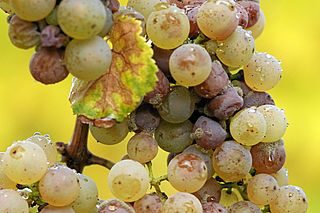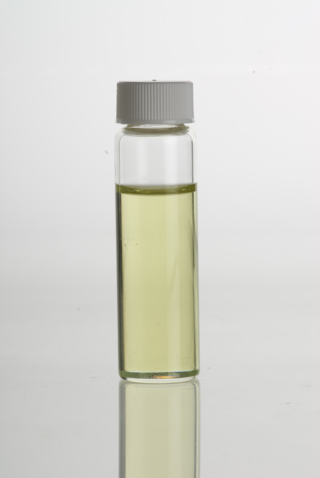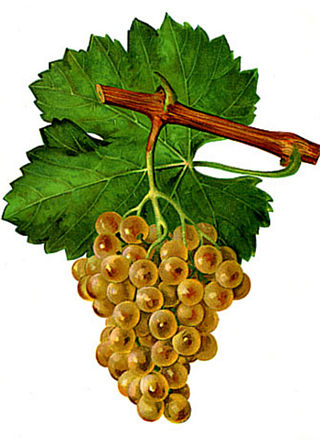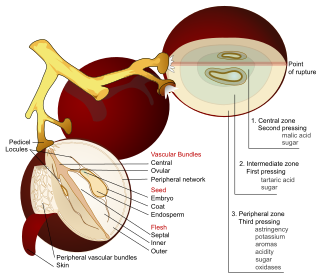
A grape is a fruit, botanically a berry, of the deciduous woody vines of the flowering plant genus Vitis. Grapes are a non-climacteric type of fruit, generally occurring in clusters.

Tartaric acid is a white, crystalline organic acid that occurs naturally in many fruits, most notably in grapes but also in tamarinds, bananas, avocados, and citrus. Its salt, potassium bitartrate, commonly known as cream of tartar, develops naturally in the process of fermentation. Potassium bitartrate is commonly mixed with sodium bicarbonate and is sold as baking powder used as a leavening agent in food preparation. The acid itself is added to foods as an antioxidant E334 and to impart its distinctive sour taste. Naturally occurring tartaric acid is a useful raw material in organic chemical synthesis. Tartaric acid, an alpha-hydroxy-carboxylic acid, is diprotic and aldaric in acid characteristics and is a dihydroxyl derivative of succinic acid.

Noble rot is the beneficial form of a grey fungus, Botrytis cinerea, affecting wine grapes. Infestation by Botrytis requires warm and humid conditions, typically around 20 degrees celcius and above 80% humidity. If the weather stays wet, the undesirable form, "bunch rot" or "grey rot", adversely affects winemaking by disrupting fermentation and changing the taste, aroma, and appearance of the final wine Grapes typically become infected with Botrytis when they are ripe. If they are then exposed to drier conditions and become partially raisined, this form of infection is known as noble rot. Grapes picked at a certain point during infestation can produce particularly fine and concentrated sweet wine. Wines produced by this method are known as botrytized wines, and are considered a distinct category of dessert wines.

Winemaking, wine-making, or vinification is the production of wine, starting with the selection of the fruit, its fermentation into alcohol, and the bottling of the finished liquid. The history of wine-making stretches over millennia. There is evidence that suggests that the earliest wine production took place in Georgia and Iran around 6000 to 5000 B.C. The science of wine and winemaking is known as oenology. A winemaker may also be called a vintner. The growing of grapes is viticulture and there are many varieties of grapes.

Grape seed oil is a vegetable oil derived from the seeds of grapes. Grape seeds are a winemaking by-product, and oil made from the seeds is commonly used as an edible oil.

Sémillon is a golden-skinned grape used to make dry and sweet white wines, mostly in France and Australia. Its thin skin and susceptibility to botrytis make it dominate the sweet wine region Sauternes AOC and Barsac AOC.

Aligoté is a white grape used to make dry white wines, especially in the Burgundy region of France where it was first recorded in the 18th century. Since it is tolerant to cold, this variety is also cultivated in Eastern European countries. In 2004, it was the 22nd most planted vine variety in the world at 45,000 hectares.

Grape juice is obtained from crushing and blending grapes into a liquid. In the wine industry, grape juice that contains 7–23 percent of pulp, skins, stems and seeds is often referred to as must. The sugars in grape juice allow it to be used as a sweetener, and fermented and made into wine, brandy, or vinegar.

Vitis amurensis, the Amur grape, is a species of grape native to the Asian continent. Its name comes from the Amur Valley in Russia and China.
Hardaliye is a lactic acid fermented beverage produced from grapes, crushed mustard seeds, sour cherry leaves, and benzoic acid. It is an indigenous drink of the Trakya region of Turkey in southeastern Europe.
Hydroxycinnamic acids (hydroxycinnamates) are a class of aromatic acids or phenylpropanoids having a C6–C3 skeleton. These compounds are hydroxy derivatives of cinnamic acid.

The acids in wine are an important component in both winemaking and the finished product of wine. They are present in both grapes and wine, having direct influences on the color, balance and taste of the wine as well as the growth and vitality of yeast during fermentation and protecting the wine from bacteria. The measure of the amount of acidity in wine is known as the “titratable acidity” or “total acidity”, which refers to the test that yields the total of all acids present, while strength of acidity is measured according to pH, with most wines having a pH between 2.9 and 3.9. Generally, the lower the pH, the higher the acidity in the wine. There is no direct connection between total acidity and pH. In wine tasting, the term “acidity” refers to the fresh, tart and sour attributes of the wine which are evaluated in relation to how well the acidity balances out the sweetness and bitter components of the wine such as tannins. Three primary acids are found in wine grapes: tartaric, malic, and citric acids. During the course of winemaking and in the finished wines, acetic, butyric, lactic, and succinic acids can play significant roles. Most of the acids involved with wine are fixed acids with the notable exception of acetic acid, mostly found in vinegar, which is volatile and can contribute to the wine fault known as volatile acidity. Sometimes, additional acids, such as ascorbic, sorbic and sulfurous acids, are used in winemaking.

Phenolic compounds—natural phenol and polyphenols—occur naturally in wine. These include a large group of several hundred chemical compounds that affect the taste, color and mouthfeel of wine. These compounds include phenolic acids, stilbenoids, flavonols, dihydroflavonols, anthocyanins, flavanol monomers (catechins) and flavanol polymers (proanthocyanidins). This large group of natural phenols can be broadly separated into two categories, flavonoids and non-flavonoids. Flavonoids include the anthocyanins and tannins which contribute to the color and mouthfeel of the wine. The non-flavonoids include the stilbenoids such as resveratrol and phenolic acids such as benzoic, caffeic and cinnamic acids.

Chicoric acid is a hydroxycinnamic acid, an organic compound of the phenylpropanoid class and occurs in a variety of plant species. It is a derivative of both caffeic acid and tartaric acid.
This glossary of winemaking terms lists some of terms and definitions involved in making wine, fruit wine, and mead.

Caftaric acid is a non-flavonoid phenolic compound.

Oenin is an anthocyanin. It is the 3-glucoside of malvidin. It is one of the red pigments found in the skin of purple grapes and in wine.

In viticulture, ripeness is the completion of the ripening process of wine grapes on the vine which signals the beginning of harvest. What exactly constitutes ripeness will vary depending on what style of wine is being produced and what the winemaker and viticulturist personally believe constitutes ripeness. Once the grapes are harvested, the physical and chemical components of the grape which will influence a wine's quality are essentially set so determining the optimal moment of ripeness for harvest may be considered the most crucial decision in winemaking.

Syringic acid is a naturally occurring phenolic compound and dimethoxybenzene that is commonly found as a plant metabolite.

The grape reaction product is a phenolic compound explaining the disappearance of caftaric acid from grape must during processing. It is also found in aged red wines. Its enzymatic production by polyphenol oxidase is important in limiting the browning of musts, especially in white wine production. The product can be recreated in model solutions.

















